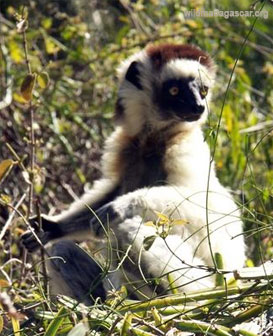Rain key to survival of baby lemurs
Stony Brook University news release
November 14, 2005
STONY BROOK, N.Y., November 14, 2005—Researchers studying lemurs in Madagascar have discovered a link between tooth deterioration and rainfall amounts that suggests long-lived mammals may be particularly sensitive to changing environmental conditions—and that reproduction and infant survival is linked to tooth wear. The study, which took place over 20 years, is reported in the November issue of the journal Proceedings of the National Academy of Sciences.
Primates are relatively long-lived and, with the exception of humans, can reproduce into old age. But tooth deterioration over time may potentially affect their reproductive success. The researchers, which included Stony Brook University’s Patricia Wright, report that after the low-crowned teeth of female lemurs wear to a point—about 18 years—the survival of infant lemurs is connected to elevated rainfall amounts during lactation seasons. Lemurs are one of the most endangered animals in the world.
“The link of reproductive success to rainfall is important to know because the areas under de-forestation and de-fragmentation are drying out,” said Patricia Wright, a Professor of Anthropology at Stony Brook, who has studied lemurs for over 25 years and is one of the world’s foremost authorities on the species. “This means this species and others will be at risk. We will need to look for solutions, and one of those may be re-forestation.”
 Verreaux’s sifaka, a commonly seen lemur in the southern and western parts of Madagascar. Verreaux’s sifaka is closely related to the sifaka lemur that was the subject of this study. |
To determine how tooth wear might influence reproduction, the husband-and-wife team of Wright and Jukka Jernvall of the University of Helsinki, and their colleagues documented tooth wear in a population of Madagascar rainforest lemurs, called sifakas, over the past 20 years. The researchers took dental casts of the sifakas’ mouths and analyzed tooth wear using Geographical Information Systems, a technology typically used to analyze and map Earth’s geographic features.
The sifakas’ crowns were found to wear flat by 18 years of age. Despite this tooth deterioration, some sifakas were able to survive and produce healthy offspring for another 10 years, as long as there was abundant rainfall during the nursing season. The researchers concluded that low-crowned teeth last to a point, after which reproductive success closely tracks environmental fluctuations. This link suggests that subtle changes in climate may affect reproductive success of rainforest species.
Related article
Dancing lemur attracts tourists to island of Madagascar
May 30, 2005
In the dry deciduous forests of south western Madagascar there lives a lemur that loudly cusses but “dances” like a ballet performer. Verreaux’s sifaka is among the most popular of lemur species, a group of primates endemic to islands off the southeastern coast of Africa. While threatened, Verreaux’s sifaka is easily spotted is several of Madagascar’s more accessible parks
This article is based on a press release from Stony Brook University. The original version appears at Tooth Wear And Rainfall Amounts Linked To Reproduction And Infant Survival Of Lemurs